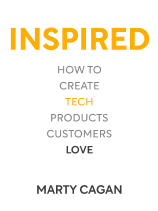

This article is an excerpt from the Shortform book guide to "Inspired" by Marty Cagan. Shortform has the world's best summaries and analyses of books you should be reading.
Like this article? Sign up for a free trial here .
Who are the most important players on a product development team? What are each person’s roles and responsibilities?
Product development teams are made up of three key positions: the product manager, the UX designer, and the engineers. Without these three key roles, a product is doomed to fail no matter how good the concept is.
Continue reading to learn about each key role, plus the five additional roles.
Product Development Teams
For a product to be successful, it needs a good product development team working on it. Every team needs to be filled with missionaries rather than mercenaries. In other words, employers should look for and cultivate those who truly believe in the product and advocate for it rather than people who only do what they’re told.
First, we’ll discuss team organization and then describe the three key positions and their responsibilities:
- The product manager
- The product (or UX) designer
- The engineers
Team Organization
In structuring a product development team:
- Maintain a relatively flat reporting structure. While some engineers may report to a more senior engineer or some UX designers may report to a more senior UX designer, no one reports directly and only to the product manager. A flat structure helps team members feel they have a say in the direction of the team and that they’re not just following orders from above.
- Have team members sit next to one another and see each other’s screens when possible, to better encourage collaboration and problem-solving.
- Make teams responsible for only part of a larger product, especially at big tech companies. This helps teams feel they “own” at least part of the product rather than being a cog in the machine, and it helps teams know where their work begins and where it ends.
- Keep teams together over multiple projects so that they can better understand each other’s work styles, strengths, and weaknesses. If most team members are missionaries who are passionate about the mission of the team and company, this is easier, because they’ll be less likely to leave the company.
- Give teams autonomy over their projects so they feel more invested in them. With greater autonomy, they’ll also have to take responsibility for understanding how their product functions.
Key Position #1: Product Manager
Among the three key product development roles, the product manager is the most critical to the success of a product development team. At a smaller company, the product manager could be the president/CEO as well.
Key Responsibilities
The product manager must understand what ideas will succeed and what ideas will fail. A product manager must be knowledgeable about:
- Customers: The product manager understands who the desired customers for a product are and what they want or need. This includes a qualitative understanding of the customer—or why customers buy—and a quantitative understanding of the customer—or exactly what they buy and at what rates.
- Data: A product manager knows how to use analytics to make good decisions. This contributes to the quantitative understanding of the customer—if a product manager understands sales and usage data, they’ll understand customer behavior better.
- The company: A product manager knows what’s going on at all levels of the company and who makes decisions. They understand the sales department and the marketing departments, but also know the CEO and what her interests are. Understanding who the stakeholders are in each part of the company helps the product manager make decisions.
- The industry: A product manager also knows the competitors and the landscape of the industry. Is it growing, which would suggest more potential competitors, or contracting, which might make it harder to make sales? In addition to knowing what competitors are doing, the product manager also has insight into changes in technology and how social media relates to the market.
A product manager at a poorly functioning team works in one of two ways:
- The product manager escalates all problems they think are important up the ladder, likely to a CEO or president.
- The product manager serves as only a meeting administrator, calling and facilitating meetings where others make decisions.
Both of these approaches devalue the role of the product manager.
Key Characteristics
Even the best product managers take a few months to learn the job, so make good hires or you’ll waste months of effort and training.
Great product managers have five important qualities:
- Smarts: This isn’t just about IQ. A smart person has to also be curious about the world, willing to learn, and constantly thinking about work beyond the 9-to-5 business day.
- Creativity: The creative product manager doesn’t limit herself to business strategies that the company has used in the past, or even to the specific assignment that the company gives her. Rather, she thinks in unique ways to achieve company goals.
- Persistence: Good product managers keep trying, even when things don’t go their way. A CEO might at first be wary of outside-the-box solutions, but a good product manager will continue pushing the CEO, using convincing data and consistent communication to get her point across.
- Leadership: The best product managers are willing to take the lead on a project, even if they aren’t technically anyone’s boss. They advocate for the ideas that they and their group have generated, and they have the people skills necessary to influence their team, their CEO, others in the company, and their industry.
- A collaborative spirit: To acquire a deep knowledge of their customers, data, the company, and the industry, product managers rely on the expertise of others. So they must be willing and able to collaborate.
Finally, every good product manager at a tech company has a basic understanding of computer programming and business. Computer programming helps them to understand their engineers, and business knowledge helps them to understand the industry. They take additional classes in these two fields if they didn’t have an introduction to them in college or graduate school.
The Lead Product Manager
Large companies developing multiple products under multiple managers have a lead product manager who coordinates department efforts. This manager is a senior executive, and has all of the same skills as the other product managers, but their primary role is to maintain a holistic view of the company and see how all of the products are fitting together (or not).
They also know how to develop teams, have a clear vision of the overall mission of the company, understand the company culture, and can execute on many disparate ideas.
Finally, the person in this role builds good relationships with both the product managers and the CEO/CFO. They’re capable of explaining their overall vision to the product managers, while also making them feel as if they are in charge of their own products. Lead product managers are also good at taking feedback from product managers, implementing it, and explaining it to the CEO/CFO.
Key Position #2: UX Designer
Most companies’ products have poor designs because they don’t worry about design as much as they think about the engineering. This is a mistake because, as Apple has proven, having a product with an interface that is visually appealing to customers is a huge competitive advantage.
Key Responsibilities
The product designer or UX (user experience) designer is responsible for designing the product with the customer and user experience in mind. Product designers ask some of the following questions when designing a product:
- Where will customers hear about the product?
- How will users interact with one another?
- What other, competing products can get in the way of the customer choosing, and subsequently using, ours?
- How will users’ experience change as they continue to use the product over time?
- What will users enjoy about the product?
- What will users find unique about the product?
- What will users tell their friends about the product?
The product designer is also a strategic partner of the product manager. While product managers have a holistic understanding of how the product functions, designers may better understand how its target audience will use it. As a result, the designer can help the product manager make decisions about all user-related questions, such as where to place a home button or whether to develop new charging technology..
Product designers answer user experience questions by working with the team to develop prototypes of the product and to test them. We’ll explore testing in detail in Part 4.
Two Types of Design
Product designers focus on two types of design: interaction design and visual design.
- Interaction design refers to the components of a product and how they work for the user. For example, if you’re designing word processing software, this would include the spellcheck feature, style and formatting tools, and all the ways that users can set up a document.
- Visual design focuses on how a product looks on the screen. Visual design is less about functionality and more about beauty.
Most product designers have some experience with both of these types of design.
The Lead Product Designer
When a company gets big enough it needs a lead product designer, just as it needs a lead product manager. The lead designer is responsible for making sure that visually, every project looks the same. Having different fonts on different products within one company, unless it is obviously intentional, just looks disorganized.
The Importance of the Product Designer to the Product Manager
We’ve already touched on why the product designer is so important, but now let’s consider what would happen if the product designer didn’t exist. The product manager would either take on all of the design herself, delegate the design to her engineers, or do the interaction design herself while delegating the visual design to a graphic designer.
None of these situations is tenable because, beyond how busy the product manager already is, it takes a specific skill set and understanding of a visual language to succeed as a designer. Bringing in a professional graphic designer might help with some of this, but they won’t have access to the consumer data from the surveys, nor will they be likely to understand the product well.
Therefore, product managers should do a few things to encourage the work of the product designer:
- Sit next to your designer.
- Clue your designer in to everything you’re doing.
- Include the designer (and have the designer lead) in some interactions with customers.
- Don’t give your designer too much feedback or any of your own design ideas—rather, let the designer solve problems.
- Make sure your designer is producing work on a consistent basis, even if it’s early on in the process. This will allow the designer to develop some creative solutions to problems that you may not think of.
Key Position #3: Engineers
Many companies think of engineers as simply cogs in their larger machinery. They are there to fix bugs and follow specific directions on how to build products. However, engineers can significantly contribute to the success of a product beyond applying their technical skills.
Key Responsibilities
Engineers are responsible for the coding and any other building that is necessary to create the product. While there is one product manager per team and generally one product designer, there are usually between two and 10 engineers per project development team.
Engineers are useful beyond pure coding, though. Because they’re intimately familiar with the way the code and machinery work, they often have the best understanding of how to expand the product (and the limitations on doing so).
Chief Technology Officer
The Chief Technology Officer (CTO) heads the engineering department. The CTO is similar to the lead product manager and product designer, but is responsible for making sure that all of the code written and other engineering done over the various products fits together. This person understands the greater strategic goals of the organization and how engineering can contribute to those goals. The CTO has six duties:
- Hire strong employees and help to develop their skills and retain them.
- Work with the rest of the leadership to decide on the strategic direction of the company.
- Make sure the engineers can deliver technically on the strategic vision in a timely manner.
- Create and sustain a structure that allows the company to scale technology quickly and reliably.
- Encourage engineers, especially the more senior ones, to contribute strategic ideas as well as programming.
- Act as the technological company liaison to potential clients, investors, or other partners.
The Importance of Engineers to the Product Manager
Engineers and the product manager need a good relationship so they can share ideas and solutions. This will benefit the team because engineers are often knowledgeable about the inner workings of the product in a way that product managers are not, and so they can often contribute unique ideas about how to build products.
It’s largely up to the product manager to build this relationship. Every day, product managers solicit engineers’ ideas, and engineers ask product managers for clarification on the goals of the product. By being knowledgeable but also soliciting feedback, product managers can turn engineers into true missionaries.
Too often, though, product managers don’t have any experience with or understanding of what engineers are working on, and so the relationship breaks down before it can even get started. This is a big reason why the product manager should understand some computer science as well as some business.
Additionally, if, as a product manager, you don’t know something, it’s better to ask for an explanation than to guess your way through. Engineers will spot the latter strategy, and you’ll lose credibility.
Marketing Professionals
Now that we have discussed how product managers, UX designers, and engineers build a product, we will examine how to market a product.
Key Responsibilities
Marketers are responsible for turning a good product into a commercial success. They are meant to show the best side of the product to potential customers. Some of their responsibilities are:
- Finding the product’s target audience
- Creating a message that will distinguish the product from its closest competitors
- Utilizing the channels or forms of media (television, radio, native advertising, SEO plays) that are most likely to catch the target audience’s attention
The Importance of the Marketer to the Product Manager
The marketer is important to the product manager because she knows how to package the product manager’s ideas. Ultimately, the product is only successful if it sells well, and the marketer helps to turn a good idea into a commercial success. This is why product managers have to explain the product in depth to the marketing team. The product manager and the marketer should communicate frequently.
Other Roles
There are several other important people that a product manager might interact with. These interactions depend on the size of the company and the type of the product, but we’ll go over them briefly here.
Researchers
User researchers, which a lot of bigger companies employ, help product managers get the most benefit from focus groups by helping to write good questions, finding people who will give useful answers, and generally finding better data for the product manager to work with.
Analysts
Some larger companies also employ analysts. As researchers help with the qualitative side of the focus groups, analysts will help with the quantitative part of the data that product managers get from surveys. These roles have become increasingly popular recently, and sometimes a team might have its own dedicated data analyst. Without someone like this, the product manager basically has to play the role of the analyst.
Test Engineers
These people are responsible for creating tests for the product. In most companies, engineers on the team will do this, but larger companies might employ specific test engineers to make sure that the product is working as it should be. These employees can be particularly helpful for engineers, as in writing the tests, they look at the product with an engineer’s capabilities and with a fresh set of eyes, so they can spot problems other engineers may have missed.
Delivery Managers
The delivery manager is a coordinator who removes obstacles to success for the product manager by scheduling meetings, liaising with other departments, or asking for approval on new initiatives. Sometimes, product managers who lack delivery managers can get so overwhelmed with coordination and an email inbox that is never empty that they are unable to think strategically or holistically.

———End of Preview———
Like what you just read? Read the rest of the world's best book summary and analysis of Marty Cagan's "Inspired" at Shortform .
Here's what you'll find in our full Inspired summary :
- A two-step plan for creating and sustaining successful technology products
- Why product managers are so important in product development
- How to avoid some of the biggest pitfalls that most tech companies fall into






